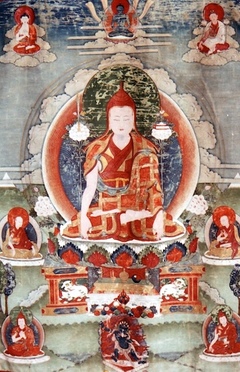Immaculate Nectar
Immaculate Nectar
by Longchen Rabjam
I pay homage to the supreme guru,
Source of every form of excellence.
I shall clarify the Immaculate Nectar,
Treasure-source of luminous samādhi.
This has three parts: advice on key points
Related to four periods of time,
And key points of Trekchö and Tögal.
The first, key points of fourfold time,
Has outer, inner and secret elements.
1. Four Periods of Time
Outer: The Four Seasons
First, the four outer periods of time
Are winter, spring, summer and autumn,
Each of which is three months long.
Wintertime is water-related and cold,
So place and conduct should heighten warmth.
Spring is the season of phlegm and earth;
It’s important to dispel lethargy and torpor.
Since summer is fiery and warm, seek cool.
Autumn features wind and mobility, so seek vivid clarity.
Base your location and conduct on what is healthiest.
Inner: The Four Periods of the Day
The key points for the four inner periods
Relate to the four elements of one’s body.
For this, day and night are divided into four.
During the day train in the illusoriness
And clear-light nature of whatever appears.
During the night hold consciousness within.
At dusk, let fire blaze from the red a (ཨ)
At the navel, melting the haṃ (ཧཾ) at the crown,
So that red and white nectar descends to the heart.
By focusing the mind on the supreme bindu,
Co-emergent wisdom will arise.
At midnight, adopt the sleeping lion posture,
Focus the mind on the white a (ཨ) in the heart,
And go to sleep while experiencing the non-referential.
At dawn, the white a shoots up from the heart,
Emerges from the crown and remains
A bow’s length above you in the middle of the sky.
Focus the mind and clear, empty wisdom will arise.
Secret: The 'Fourth' Time
As regards the secret four periods of time,
Meditate undistractedly on the wisdom of self-awareness
Which is the dharmakāya, the fourth part beyond the three.
In this, the proliferation and absorption of thought
Related to the three times—past, present and future—
Is naturally interrupted.
And you are united with non-conceptual wisdom itself.
Through familiarity with these key points related to four periods,
You will approach the genuine meaning.
2. Key Points of Trekchö
Second, there are key points related to Trekchö.
Here, natural settling after arising is crucial.
Determining Key Times for the Laudable[1] says:
"Who knows non-movement and natural disappearance?
In this there is neither permanence nor termination.
Who knows the absence of thought and recollection?
In this there is neither coming nor going.
Who nakedly recognizes one’s own nature?
In this there is neither saṃsāra nor nirvāṇa.
Thus, the identity of mind is crucial."
This is the secret key point for meditating
On lucidity with recognition after arising.
3. Key Points of Tögal
Third, there are the key points of Tögal.
Thoroughly apply the postures and gazes.
Without being drowsy, dull or distracted,
Meditate on apparent luminosity, day and night.
Insight is born directly from method.
It is crucial to integrate day and night.
Non-conceptual luminous clarity
Is explained as the essential clear light of dharmakāya.
Through practising just this, you will be
Liberated into natural great perfection.
Through the virtue of thus setting out
This supreme instruction with its three sets of points,
Synthesizing tantra, commentaries and pith instructions,
May all beings spontaneously realize the Ever Excellent!
This concludes the instruction for meditating on clear light entitled Immaculate Nectar composed by Longchen Rabjam, a yogin of the supreme vehicle.
| Translated by Adam Pearcey with the generous support of the Tsadra Foundation, 2024.
Bibliography
Tibetan Edition
klong chen rab 'byams pa dri med 'od zer. "bdud rtsi dri med" In snying thig ya bzhi. 13 vols. Delhi: Sherab Gyaltsen Lama, 1975. Vol. 2: 227–230.
Version: 1.1-20240812
-
An alternative title for Instructions on the Tantra Called Single Child of All the Buddhas (sangs rgyas thams cad kyi sras gcig gi rgyud kyi man ngag ces bya ba), from the Vima Nyingtik. ↩
